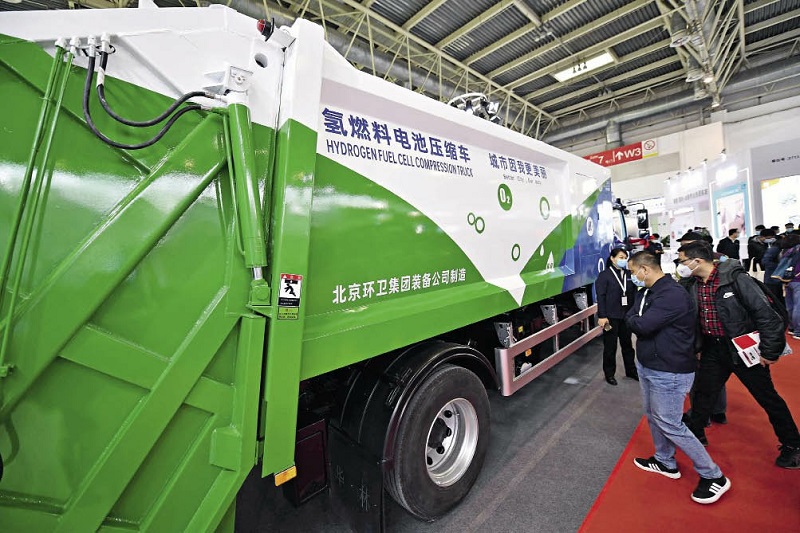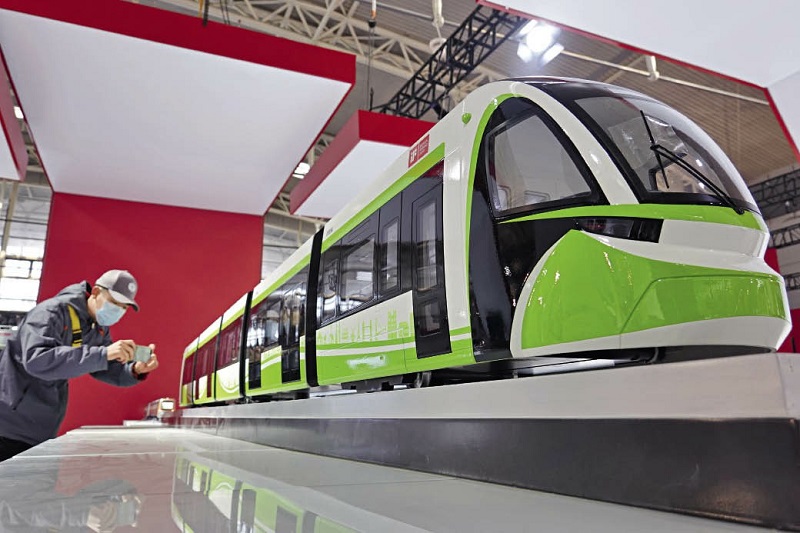Faced with the increasing threat from global warming, the importance of limiting the rise of the global temperatures within 1.5 degrees Celsius has become self-evident. To meet the Paris Agreement objective, by the end of this century, global carbon dioxide emissions are expected to fall to zero.
As for China, in September 2020, President Xi Jinping announced the meaningful goal of reaching carbon neutrality by 2060. This not only demonstrates China’s determination to go green, but will also serve as a stimulus for Chinese companies to accelerate technological innovation and industrial upgrading towards a green and sustainable economic development mode.
China’s promise for carbon neutrality by 2060 has set a good example for other nations. Within weeks of Xi’s announcement, Japan and South Korea followed suit by launching their own carbon-neutral targets respectively.

A hydrogen fuel cell compression truck independently developed by Jinghuan Equipment, a subsidiary company of Beijing Environmental Sanitation Engineering Group, is launched on November 13, 2020.
A Key Sector for Realizing the 2060 Goal
In China, going carbon neutral means to drastically reduce carbon emissions. According to the World Resources Institute (WRI), energy production, industries, transportation, construction, and agriculture and land use are the top five carbon emitting sectors in China. Among them, the transportation sector, accounting for nine percent of the country’s total carbon emissions, remains a hard nut to crack.
Let’s take Germany, a manufacturing power with a similar economic structure to China, for example. Germany started decarbonizing its economy in the 1990s. By 2017, even though its total greenhouse gas emissions had fallen by a third, emissions from its transportation sector were still going up. This is a lesson for China.
In February, the State Council of China released the “Outline of the National Comprehensive Three-Dimensional Transportation Network Planning.” The document laid out China’s transportation program going forward to 2035, clearly noting that carbon dioxide emissions in the transportation sector should peak as soon as possible, and its emission intensity in 2035 should be significantly lower than it was in 2020.
The road ahead of China in reaching this goal will not be an easy one. For one, carbon emissions in the transportation sector are very complicated, ways of discharging are diverse, emission structures vary, and methods for calculating emission amount are complex, making it difficult to decide where to begin. Having said that, the good news is that according to research, road transport has the greatest potential as a ringleader in this sector to lead carbon emissions.
According to the Second Biennial Update Report on Climate Change in China, in 2019, road traffic took up 84.1 percent of China’s transportation emissions. To be specific, as a manufacturing power, and a world leading economy in the online consumption field, China’s freight transport consumed half of its total energy, making it far higher than the international average of 37 percent, leaving big room for emission reduction.
In passenger transport, automobiles motorcycles used up to 45 percent of energy, while public transport only used 4 percent. Emissions from cycling and other modes are so low that they are not worth mentioning here. As we can see, a structural shift prioritizing green travel and the promotion of electric cars would be significant for the transportation sector to cut down carbon emissions.

A visitor takes photos of an autonomous-driving tram model at the exhibition of Excellent Industrial Design Award in China at the World Industrial Design Conference (WIDC) 2020.
Achieving Carbon Neutrality in Road Transport
Globally speaking, developed countries are also trying their respective green deals to decarbonize their transportation industry, making it an important starting point for economic recovery and transformation in the post-pandemic era.
In the European Green Deal, the EU pointed out that investment in green transportation infrastructure should be increased by improving the transport capacity of railway freight and inland river shipping, developing the intelligent connected vehicle industry and intelligent transportation system, and increasing the construction of EV charging piles.
The America Rescue Plan of the Biden administration also pays much attention to the transportation industry, including strengthening investment in intercity rail transit construction, maintaining the normal daily operation of public transportation, accelerating the development of the new energy vehicle industry and charging stations, and developing autonomous driving.
In recent years, China has implemented a series of policies to address climate change in the road transport sector. At the same time, the development and breakthroughs of science and technology have also brought the road transport industry into an unprecedented period of technological innovation.
Clean technologies such as new energy batteries and vehicles are developing rapidly, and AI and big data technologies are also widely applied in the transportation industry. In China, the number of new-energy vehicles accounts for nearly half of the world’s total. The development of green travel, such as bike-sharing and unmanned driving, is presently leading the international trend and presenting unprecedented opportunities for emission reduction in the transportation sector.
However, to go from the “peak” to “neutrality” means that emissions in China’s road transport sector need to go from peak to zero within 30 years. This not only calls for drastic reforms, but also technological breakthroughs. Another report from WRI about the paths to “net zero” emissions in China’s road transport by 2050 recommends that the following key actions be taken:
First, reach a 35 percent carbon emission reduction through a change in transport patterns: develop a new freight transport mode featuring highway-railway and highway-waterway connection, promote green travel, increase the protection of the rights of road for public transportation, promote the network of vehicles and digital road infrastructure, rationally allocate urban street functional space, and implement a regional pedestrian and bicycle system planning.
Second, realize another 35 percent emission reduction through decarbonizing vehicle fuels: accelerate vehicle electrification and low-carbon fuel replacement. In addition to promoting new energy passenger vehicles, more electric vehicles are also needed in urban logistics and intercity freight transportation.
Third, contribute 12 percent emission shrinkage to the carbon-neutral target by reducing vehicle miles traveled: establish a charging mechanism in road traffic based on the carbon consumed and make use of the pilot zero-emission zones across the country to tap into the potential of the market in carbon-neutral transportation.
In addition, the remaining 18 percent reduction will require cross-sector cooperation, and shall be achieved by resorting to clean power grids and renewable energy sources.
The 14th Five-Year Plan period is the first five-year period after China’s embarking on a new journey to build a modern socialist country in all respects. A zero-emission path for road transport and related pilot work will not only drive green growth in the post-pandemic era, but also promote the progress of China’s carbon neutral goal.
LIU DAIZONG is director of the World Resources Institute (WRI) China Sustainable Cities Program.